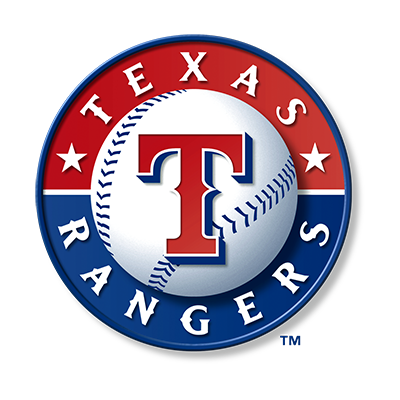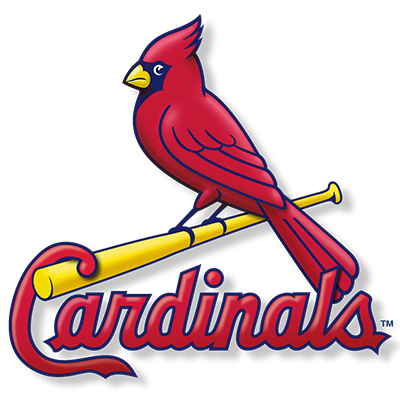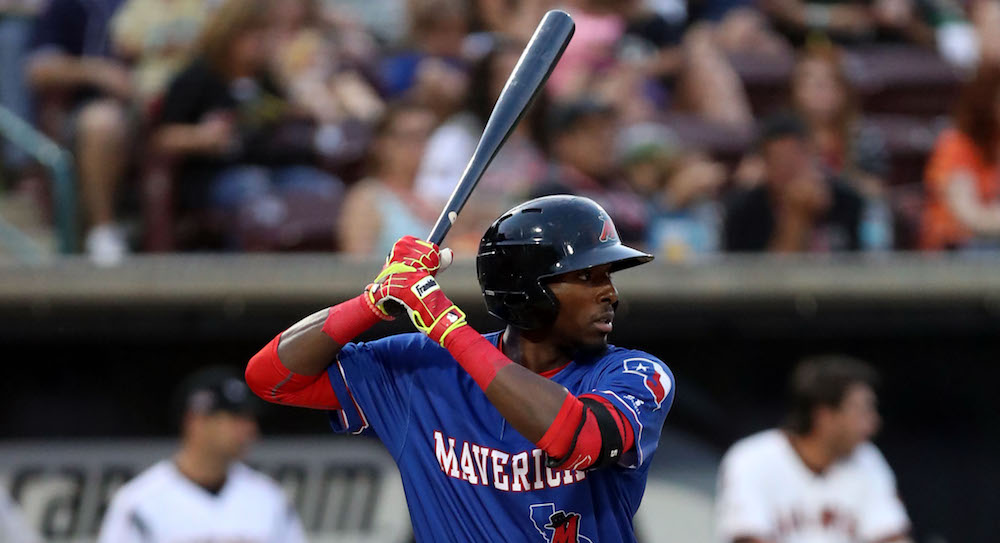Feature Photo: Travis Demeritte, 2B, Rangers
Chaz Fiorino sat on the Phillies’ Double-A Reading affiliate last weekend, and profiles three prospects that caught his eye. Dave DeFreitas takes a look at two position players from the Rangers’ High A High Desert affiliate, and Nick J. Faleris profiles Cardinals prospects Magneuris Sierra and Sandy Alcantara, currently playing for Class A Peoria in the Midwest League. Plus, our Report Library has been updated with nine new reports, including a fresh look at Joshua Sborz (RHP, Dodgers) from 2080’s Ryan Ozella.
Double-A Prospect Spotlights
 Jorge Alfaro, C, Phillies (Double-A Reading, Eastern League)
Jorge Alfaro, C, Phillies (Double-A Reading, Eastern League)
Ht/Wt: 6’2” / 225 B/T: R/R Age: 23 yrs, 0m
I was able to view Alfaro for three games behind the plate during Reading’s recent three-game series at Double-A Portland. The recently turned 23-year-old catcher showed off some serious raw power, arm strength, and surprising athleticism during this look. The first thing to stand out with Alfaro was the easy raw power in batting practice with above-average bat speed. Alfaro showed power to all fields in BP and translates that power into games with a slight bat waggle to generate rhythm and timing in his load – albeit with a slight hitch in his swing. He whips the bat through the zone with leverage in his swing from his large frame.
During the third game of the series; Alfaro showed off the in-game power by gearing up for a 3-1 fastball and pulling it to left field for a home run; as you might hope and expect from any big league-caliber hitter in that count/situation. Outside of the raw power, Alfaro demonstrated some serious swing-and-miss in his approach during this look. Alfaro appeared to be up there guessing, and he was often fooled on any type of decent breaking balls or off-speed stuff though he did, at times, show the ability to control the barrel and square up hanging off-speed and bad breaking balls.
Defensively, Alfaro showed off well above-average arm strength and limited the running game all series. With Portland hesitant to test his arm, Alfaro showed the willingness and aggressiveness to try and back pick runners at first base on a number of occasions with laser-like, on the money throws. Alfaro looked like a guy that loved to catch and take control of the game from behind the plate. It’s also worth noting that given Alfaro’s size and thick catcher’s build, he actually ran surprisingly well, with some 4.4 run times from HP-to-1B with clear athleticism. – Chaz Fiorino
 Ricardo Pinto, RHP, Phillies (Double-A Reading, Eastern League)
Ricardo Pinto, RHP, Phillies (Double-A Reading, Eastern League)
Ht/Wt: 6’0” / 165 B/T: R/R Age: 22 yrs, 5m
I got my first live look at Pinto during his June 25 start at Double-A Portland. Pinto had a short, quick, and clean arm action from a high three-quarters arm slot. He ranged from 90-to-96 mph with the fastball, and mostly sat 92-to-95 mph over 6.2 IP. Command and control of the pitch wavered throughout, lacking much movement outside of some arm-side run when down in the zone.
Pinto’s best weapon was his changeup, thrown at 83-to-86 mph. He showed confidence to throw in any count and it effectively generated swings-and-misses. The changeup is a future above-average grade offering and potential weapon to complement Pinto’s mid-90s fastball, and the pitch could play up further with improved fastball command and the potential to add strength to his skinny frame at present.
Pinto also threw a fringe-average slider at 79-to-83 mph that I could see developing into a potential average-grade offering given his quick, clean arm action and athleticism. Given Pinto’s size, he may be best suited in a future bullpen role, where he can conceivably air it out with the fastball and compliment with a plus changeup through short stints rather than expecting him to hold up in a rotation for 180+ innings. – Chaz Fiorino
 Nick Pivetta, RHP, Phillies (Double-A Reading, Eastern League)
Nick Pivetta, RHP, Phillies (Double-A Reading, Eastern League)
Ht/Wt: 6’5” / 220 B/T: R/R Age: 23 yrs, 4m
I got my first live look at Pivetta during his 6/24 start at Double-A Portland. The 23-year-old right-hander quickly stood out as a result of his large frame and a fastball that sat 91-to-95 mph with some arm-side run. Pivetta was chased after 91 pitches through four innings, and the 10 hits he gave up were largely as a result of poor fastball command.
He showed a four-pitch mix that included a curveball, slider, and changeup. The curveball was the best of the secondaries, with 11-to-5 shape and presenting as an average grade offering for me. The average grade was moreso of a result of his ability to locate it back door to left-handed hitters and get-over for strikes early in counts. The slider also showed average potential, and the changeup was a clear fourth pitch that was firm and lacked much movement. – Chaz Fiorino
Single A Prospect Spotlights
 Travis Demeritte, 2B, Rangers (High A High Desert, California League)
Travis Demeritte, 2B, Rangers (High A High Desert, California League)
Ht/Wt: 6’0”/180 B/T: R/R Age: 21 yrs, 9m
Demeritte, the New York native and 2013 1st-round draft pick, is headed to the Futures Game next month, and deservedly so. Through 73 games, the second baseman has put up a .904 OPS and a .340 OBP, which is doubly impressive seeing as he strikes out over 30% of the time. Demeritte has a lean, wiry-strong frame and is a very good athlete. His swing has a slight uphill plane that results in too many lazy fly balls, but his lightning-quick hands translate to plus bat speed that should play well as he advances. He leads the Cal League in home runs, but at least some of that should be attributed to the incredibly hitter-friendly parks that he is playing in every day. He has a very pull-oriented approach at the plate right now, and when down in the count he’s far too susceptible to breaking stuff out of the zone. However, the raw power is real, he gets excellent carry on his line drives, and his swing is short enough to where he should eventually find his share of doubles in the right-center field gap as he learns to adjust.
He has not been overly tested on defense in my looks thus far, but the athleticism is obvious, and the actions are very smooth. He has very loose arm action, and arm strength that he can maintain on the move from different angles. At times his actions are so easy that it may look like the effort isn’t there. He is not a real high-energy guy to begin with, and he definitely has some swagger to his play, but ultimately I see him as the type of player that will respond to challenges and be able to make the adjustments at each level going forward. I did not get to see him run much in the games that I saw, and while I don’t expect him to be a big base-stealing threat, saying he will stay an average runner isn’t a stretch. Given the body type, position, actions and power potential I am sure there are those who want to compare him to Brandon Phillips (2B, Reds). However, Phillips has been an elite defender for many years – I’m not sold that Demeritte is of that ilk. Also, the swing and miss that will plague Demeritte as he moves up was never that much of an issue for Phillips.
I will need to see more of Demeritte before being comfortable with a true big league comparison, but with the athleticism, bat speed and strength potential, the ingredients appear to be there for him to eventually impact a big league roster. The Rangers sit atop their division right now, and given how they have Rougned Odor manning second base for the foreseeable future, Demeritte has to be a tempting trade piece should the club look to bolster its pitching staff at the trade deadline next month. – Dave DeFreitas
 Jairo Beras, RF, Rangers (High A High Desert, California League)
Jairo Beras, RF, Rangers (High A High Desert, California League)
Ht/Wt: 6’6”/195 B/T: R/R Age: 21 yrs, 6 m
Beras has a bit of a rocky start to his pro career where he was suspended for a year over an age discrepancy issue after signing in July of 2012. He is now 21 years old, and looks to be right on track in his development. His skinny, lanky frame boasts some strength projection, but does not seem like it will ever get “thick” and is probably more of an Alex Rios (OF, Royals) body type in the future than that of fellow Ranger, right fielder Nomar Mazara. He has long levers and should continue to get pounded inside as he advances and faces better pitching, but in my short look he showed surprising ability to get the barrel to the ball down and in without having to cheat. He stands fairly upright in the box with good balance and excellent body control for how big he is. He shows above average to plus raw power right now, and will see more as the body matures. He has the ability to drive the ball out to any part of the ballpark, but the approach has a ways to go as he tends to get pull happy.
That said, the Cal League can be a blessing and curse for young power prospects–while it may boost confidence, it can also make it easy for guys to get away from their potential and start trying to jerk everything rather than using the whole field. The 30% K rate that he is sporting currently is a concern, but it’s more related to approach than any mechanical flaw, and as he learns to compete and adjust, the tools are there for him to make significantly more contact. 25 of his 53 hits have gone for extra bases, so the contact-to-damage ratio is solid – once he does the math on that, the athleticism and bat speed are there to support a more concerted effort to be more disciplined and drive the ball the big part of the field.
As far as defense goes, he moves well in right field and is aggressive going into the gaps. He showed a plus arm from the corner with good arm action and minimal tail. He is a bit duck-footed and tends to walk on his heels, but looks much better on the run with an athletic gait down the line and long strides underway. He won’t be a base-stealing threat and will likely check in at below average by the time he gets to the Show. Overall, this is a kid with tremendous upside and a chance to be an impact player at the plate. There are some in the industry that feel Beras is his own worst enemy and that ultimately his casual approach to the game will keep him from reaching his ceiling; and that he wouldn’t be the first immensely-talented prospect to not maximize his potential. But while there is merit to those types of concerns with any player, this is a 21- year-old kid we are talking about who not only grew up in an environment that most of us have no concept of, but also is just now really learning what it means to have structure and focus. The Rangers organization seems to have a tendency to be optimistic with regard to perceived makeup issues and likes to bet on the individual rather than the history. Of course the plus tools and natural ability definitely factor in when the club decides where to invest their confidence, but Texas has a nurturing air about them that pays dividends in the player development process, and that process may allow them to tap into potential that other organizations may miss out on. – Dave DeFreitas
 Magneuris Sierra, OF, Cardinals (Class A Peoria, Midwest League)
Magneuris Sierra, OF, Cardinals (Class A Peoria, Midwest League)
Ht/Wt: 5’11” / 160 B/T: L/L Age: 20 yrs, 3m
Sierra is a legit four-tool talent with an up-the-middle defensive profile, and a chance to grow into a top-of-the-order threat. After struggling in his first taste of full-season ball in 2015 at the ripe old age of 19, Sierra returned to Peoria to start the 2016 season, and he has shown growth in his game across the board. He relies on strong wrists and good feel for the barrel to square up the ball with some regularity, though his overly aggressive approach often leads to empty swings, and leaves him vulnerable to quality secondaries. On the grass, Sierra continues to improve his reads and routes, and looks the part of a future plus defender in center field.
Though he only made one start in the Chiefs’ series in Beloit this week, it was a solid showing that highlighted both the strengths and weaknesses in Sierra’s game. At the plate, Sierra showed an ability to drive the ball the other way on a hard single to left on an elevated fastball, as well as an explosive first step out of the box that earned him an infield hit on a soft grounder to second, and had him clocking 3.9 seconds to reach first base on a jailbreak ground ball that was mishandled by first baseman Ryan Howell.
His aggression was exploited, as well, as Sierra swung at two-thirds of the pitches he saw, struck out chasing, and made soft contact on four of the five balls he put in play, often hitting from behind in the count. On the base paths Sierra moved well, but struggled mightily getting a read on first base, often lunging back to first on pitches to the plate and getting thrown out easily on two stolen base attempts.
Defensively, Sierra shined, tracking down a deeply driven ball and finishing with an over-the-shoulder grab at the wall before spinning and delivering a one-hop throw from the track to the second-base bag. His reads off the bat were clean and his routes efficient. Sierra profiles as a future center fielder that should provide value both in the field and on the bases. His future offensive output comes with a higher degree of potential volatility, however. While he shows good balance at the plate, a feel for contact, and strong wrists capable of spraying the ball to all fields, his bat-to-ball skills are shy of elite, and there is a risk that his aggressive tendencies eat into his hit tool and on-base production. There isn’t much in the way of present or future power, though a more refined approach and improvement in finding balls to drive to the gaps could help Sierra to rack up extra bases thanks to his plus to double-plus speed. The upside is that of a quality top-of-the-order stick, though even as a down-order bat he could grow into an everyday contributor thanks to his glove, arm and legs. – Nick J. Faleris
 Sandy Alcantara, RHP, Cardinals (Class A Peoria, Midwest League)
Sandy Alcantara, RHP, Cardinals (Class A Peoria, Midwest League)
Ht/Wt: 6’4” / 170 B/T: S/R Age: 20 yrs, 10m
Alcantara has an electric arm, regularly reaching triple-digits with his fastball, and has made developmental strides with both his changeup and curveball thus far in 2016. The quality of his stuff has regularly overpowered Midwest League opponents, and has powered an impressive strikeout rate of 12.1 Ks-per-9. As is often the case with young power arms, Alcantara also struggles to control his stuff, often missing his spots and regularly slipping into bouts of legitimate wildness, as evidenced by both his 5.0 BBs-per-9 rate, and the surprisingly high rate at which he allows base hits (almost one per inning).
In Tuesday’s start against Beloit, Alcantara wowed with his pure stuff, sitting comfortably in the 94-to-98 mph range and hitting 100 mph on multiple occasions, including the second pitch of the game, and again during his last inning of work (the fifth). His heater gets straight at higher velocities, and particularly so up in the zone, but he also flashed a little bit of arm-side life in the 94-to-96 mph velo belt.
His second-best offering on the start was a quality changeup with arm-side dive, sitting 88-to-92 mph. Alcantara shows solid deception, with the offering coming both out of an arm slot and on a trajectory that dovetail with the heater. He was more effective with the offering early on, shifting over to a focus on the breaking ball after the first couple of innings of work. The pitch projects as a potential plus offering with legit swing-and-miss action.
His curveball flashed plus with hard 11-to-5 break, sitting in the low 80s. It worked as an early-count offering for a strike, and also as a chase pitch when working ahead. There is inconsistency in his execution still, leading to soft versions of the breaker that float up and to his arm side, as well as hard and firm darts in the dirt. He spins the pitch well, overall, and the offering projects as a future weapon that could grade out as above average or better at maturity.
Overall, Alcantara is still a little too timid with his stuff, though he should learn to throw with more confidence as he continues to refine his execution, and as he finds more consistency across his arsenal. He flashed some feel for sequencing, particularly working backwards off of his changeup, and the body works well enough that there is reason to believe both the control and the command will improve with reps. It’s an impressive arm that could grow into a legit front-end starter at maturity, but there is a lot of developmental ground to cover before the Dominican product can reach that lofty upside. – Nick J. Faleris
This Week at 2080 Baseball…
Reports Filed:
Phillip Pfiefer, LHP, Braves (High A Carolina, Carolina League)
Joshua Sborz, RHP, Dodgers (High A Rancho Cucamonga, Cal League)
Jeff Springs, LHP, Rangers (High A High Desert, Cal League)
Adam Quintana, RHP, Rangers (High A High Desert, Cal League)
Cole Wiper, RHP, Rangers (High A High Desert, Cal League)
Shun Yamaguchi, RHP, YOKOHAMA DeNA BayStars (NPB)
Randy Messanger, RHP, Hanshin Tigers (NPB)
Dennis Sarfate, RHP, Fukuoka SoftBank Hawks (NPB)
Dai-Kan Yoh, CF, Hokkaido Nippon-Ham Fighters (NPB)
2080 Content
- Nick J. Faleris kicks off our 2017 MLB Draft Class Video Library with five prospect videos.
News and Notes
- Since being drafted in 2008, Yankees catcher Kyle Higashioka (Double-A Trenton, Eastern League) has come out of the shadows of several other high-profile Yankees’ catching prospects to become a complete player, writes Jed Weisberger of pinstripedprospects.com
- With Danny Espinosa and Daniel Murphy firmly entrenched at SS/2B for the Nationals, top minor league prospect Trea Turner (SS/OF, Triple-A Syracuse, International League) is being exercised out in center field for the first time, as Washington seeks to find room for his bat in the big leagues this year, writes Chelsea Janes of the Washington Post.
- Phillies right-hander and former #1 overall draft pick Mark Appel (Triple-A Lehigh Valley, International League) is done for the season following elbow surgery, writes Yong Kim of philly.com.
- Moving SS Ozzie Albies from Triple-A Gwinnett to Double-A Mississippi to play second base alongside SS Dansby Swanson is the clearest sign yet of how the Braves will develop their top prospects moving forward, says David O’Brien of the Atlanta Journal-Constitution.


